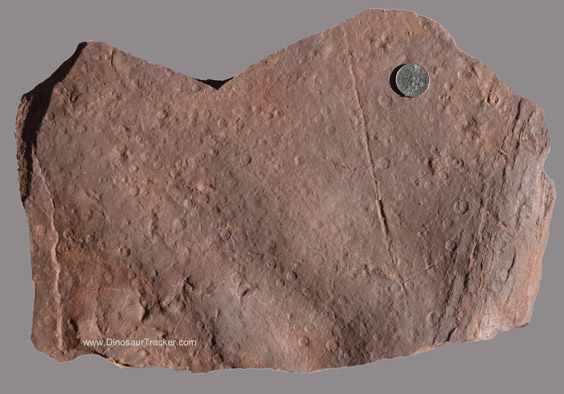Fossil Raindrops are Impossible:

The above shows a plate (stone slab) with raindrop impressions from our museum. They look like small craters all over the surface of the rock. How is it possible for raindrop impressions to be preserved and fossilized? They are even more delicate than dinosaur footprints!
In a previous section we discussed techniques for lighting and observing fossil raindrop impressions. In this section we look at preservation and fossilization of raindrop impressions.
What Are These Faint Dimples
Try to imagine a situation in which raindrop impressions in mud would last long enough to become fossilized. No dinosaur walked on them. No animal walked on them. In addition, there are not many of them on this rock. It looks like a very brief shower blew through. Or perhaps they were very quickly submerged or buried, preventing additional raindrops from falling on this surface, and protecting them. If left exposed, even a little additional rain would create mud mush and wipe away the initial raindrop impressions. This fossil requires mud firm enough to take and hold the raindrop impression. Then, it was either a very brief shower, or they were quickly, yet gently buried.
Raindrop fossils are not rare. You can buy rocks with raindrop impressions on EBay for prices as low as $25 to $30. How could such a common fossil... raindrop impressions... initially last long enough to become fossils? We don't see this happening today. We don't even see raindrop impressions in mud that has dried in the sun, supposedly an early step in creating a fossil.
The Only Option...
We don't see any conditions today that could preserve raindrop impressions. In addition this rock shows distinct raindrop impressions, and what appear to be underprint (fainter, less distinct) raindrop impressions. This is an indication that the sediment was building up as rain was making impressions in the mud. That is impossible. Or is it.
The raindrop impressions are scattered about. If the surface was not changing, this was a very brief shower. But, what it it was raining and this mud was under a thin layer of water with a heavy load of sediment. More like a slurry than water. The rain would make a few impressions. Then the water would gently flow in (rise a little), preventing the rain from making impressions and depositing a new, thin layer of of sediment. The water level then dropped a little and the new layer of sediment was very briefly exposed. And the cycle repeated.
Rolling Sedimentation
A hypothetical option for how raindrops and dinosaur footprints were preserved is called "rolling sedimentation." This describes a thin layer of sediment slurry moving forward across a flat bed of wet sediment. As the sediment slurry moves forward the front edge portion in contact with the existing sediment stops moving and is deposited. The effect is like that of unrolling a carpet. Another analogy would be that of a paint roller. As it moves it leaves behind a thin layer of paint, or in this case a thin layer of sediment. Each layer would be briefly exposed, and then covered by the next layer of "rolling sedimentation." This would give a result that matches the observed fossil raindrop and footprint impressions and thin sediment layers.
No one was there to observe what happened, and little research has been done on fossil raindrops. What we do know is that there is no observed condition in which raindrops can fossilize today. We also know there are a lot of fossil raindrop impressions around the world. Like dinosaur footprints they are on flat bedding planes with no signs of growing vegetation.
Next - Dinosaur Eggs